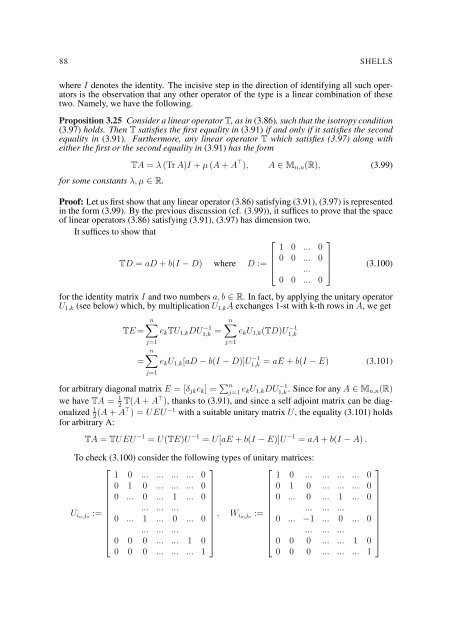EQUATIONS OF ELASTIC HYPERSURFACES
EQUATIONS OF ELASTIC HYPERSURFACES
EQUATIONS OF ELASTIC HYPERSURFACES
You also want an ePaper? Increase the reach of your titles
YUMPU automatically turns print PDFs into web optimized ePapers that Google loves.
88 SHELLS<br />
where I denotes the identity. The incisive step in the direction of identifying all such operators<br />
is the observation that any other operator of the type is a linear combination of these<br />
two. Namely, we have the following.<br />
Proposition 3.25 Consider a linear operator T, as in (3.86), such that the isotropy condition<br />
(3.97) holds. Then T satisfies the first equality in (3.91) if and only if it satisfies the second<br />
equality in (3.91). Furthermore, any linear operator T which satisfies (3.97) along with<br />
either the first or the second equality in (3.91) has the form<br />
for some constants λ, µ ∈ R.<br />
TA = λ (Tr A)I + µ (A + A ⊤ ), A ∈ M n,n (R), (3.99)<br />
Proof: Let us first show that any linear operator (3.86) satisfying (3.91), (3.97) is represented<br />
in the form (3.99). By the previous discussion (cf. (3.99)), it suffices to prove that the space<br />
of linear operators (3.86) satisfying (3.91), (3.97) has dimension two.<br />
It suffices to show that<br />
TD = aD + b(I − D) where D :=<br />
⎡<br />
⎢<br />
⎣<br />
1 0 ... 0<br />
0 0 ... 0<br />
...<br />
0 0 ... 0<br />
⎤<br />
⎥<br />
⎦ (3.100)<br />
for the identity matrix I and two numbers a, b ∈ R. In fact, by applying the unitary operator<br />
U 1,k (see below) which, by multiplication U 1,k A exchanges 1-st with k-th rows in A, we get<br />
TE =<br />
=<br />
n∑<br />
n∑<br />
e k TU 1,k DU −1<br />
1,k =<br />
j=1<br />
n∑<br />
j=1<br />
j=1<br />
e k U 1,k [aD − b(I − D)]U −1<br />
1,k<br />
e k U 1,k (TD)U −1<br />
1,k<br />
= aE + b(I − E) (3.101)<br />
for arbitrary diagonal matrix E = [δ jk e k ] = ∑ n<br />
j=1 e kU 1,k DU −1<br />
1,k . Since for any A ∈ M n,n(R)<br />
we have TA = 1 2 T(A + A⊤ ), thanks to (3.91), and since a self adjoint matrix can be diagonalized<br />
1 2 (A + A⊤ ) = UEU −1 with a suitable unitary matrix U, the equality (3.101) holds<br />
for arbitrary A:<br />
TA = TUEU −1 = U(TE)U −1 = U[aE + b(I − E)]U −1 = aA + b(I − A) .<br />
To check (3.100) consider the following types of unitary matrices:<br />
⎡<br />
⎤<br />
⎡<br />
⎤<br />
1 0 ... ... ... ... 0<br />
1 0 ... ... ... ... 0<br />
0 1 0 ... ... ... 0<br />
0 1 0 ... ... ... 0<br />
0 ... 0 ... 1 ... 0<br />
0 ... 0 ... 1 ... 0<br />
U io ,j o<br />
:=<br />
... ... ...<br />
0 ... 1 ... 0 ... 0<br />
, W io ,j o<br />
:=<br />
... ... ...<br />
0 ... −1 ... 0 ... 0<br />
⎢ ... ... ...<br />
⎥<br />
⎢ ... ... ...<br />
⎥<br />
⎣ 0 0 0 ... ... 1 0 ⎦<br />
⎣ 0 0 0 ... ... 1 0 ⎦<br />
0 0 0 ... ... ... 1<br />
0 0 0 ... ... ... 1

















